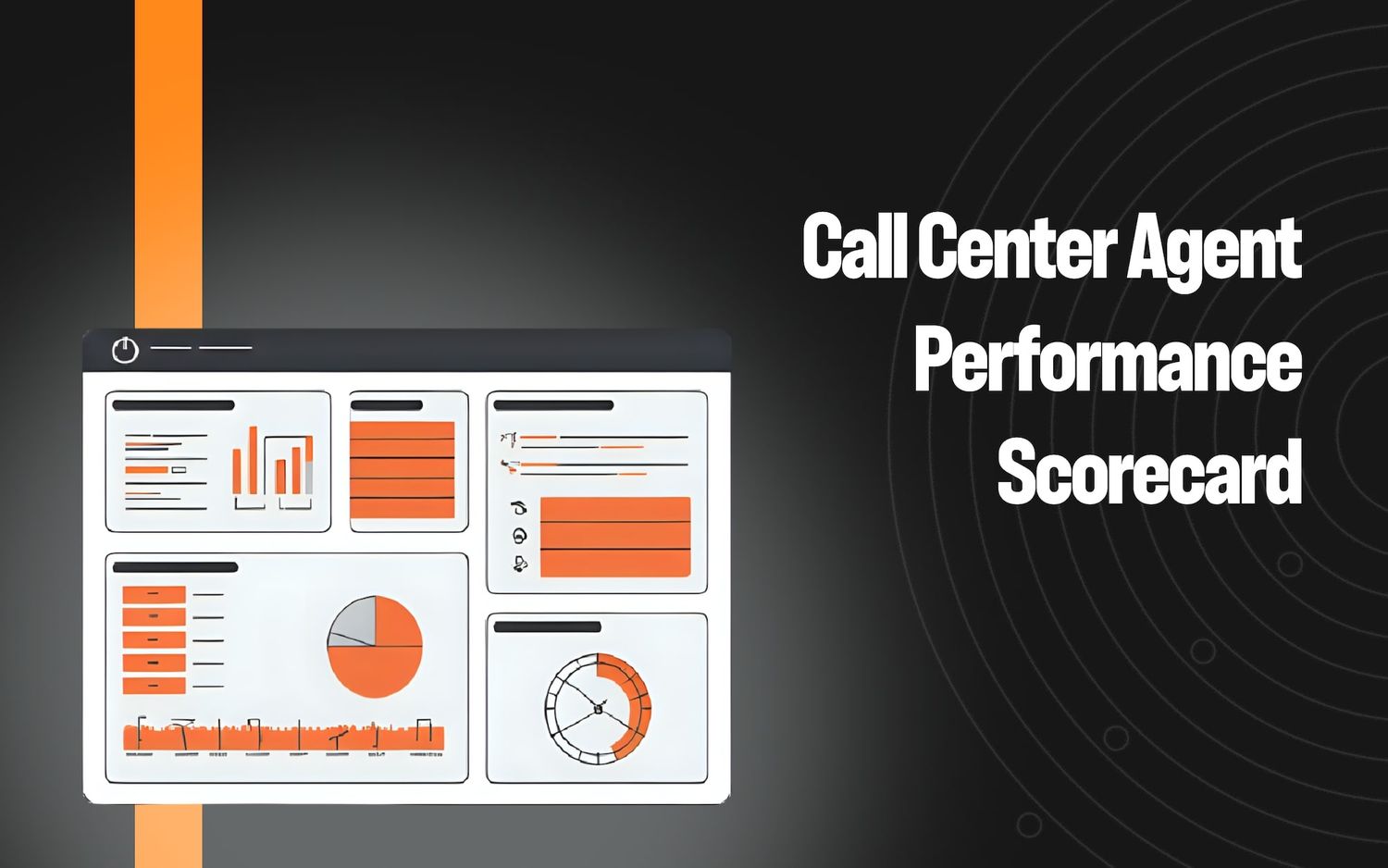Top 7 Contact Center Automation Tools for 2025


Contact center automation is all about using technology to make things faster and simpler for customers and agents. These tools handle repetitive tasks, cut down on mistakes, and help contact centers work more smoothly.
The main goals of automation are to:
- Make the customer and agent experience better.
- Simplify tasks like routing calls, entering data, and booking appointments.
- Let teams get more done without needing more staff.
Automation covers both customer-facing tools and behind-the-scenes support for your team. It's not just about chatbots and interactive voice response (IVR): it’s about giving your contact center the ability to move quicker and work better.
Here are some examples of what contact center automation can do:
- IVR systems and voice bots that guide callers and direct them to the right place.
- Chatbots and virtual assistants that answer common questions and pass on tough ones to their human counterparts.
- Robotic process automation (RPA) that handles tasks like opening tickets or updating customer records.
- Workflow automation tools that manage multi-step processes like onboarding, approvals, or data syncing.
- Real-time agent assist that shows helpful info or tips to agents while they’re talking to customers.
- Sentiment analysis tools that check how customers feel and track satisfaction trends.
Below, we review the top 7 contact center automation tools, starting with our own platform, Level AI, which automates quality assurance by surfacing customer insights and agent coaching opportunities.
Table of Contents
What to Look for in a Contact Center Automation Tool
Contact center automation isn’t new. It’s been around for decades in the form of IVR menus, rule-based call routing, and workflow tools that followed rigid scripts. These early systems certainly automated basic tasks, but they lacked flexibility and intelligence.
For instance, if a customer called in and said “returns,” any IVR system could route them to the returns line. But if they said something more nuanced, it could also misroute them.
Today’s automation tools, in contrast, can handle nuance like this much better because they use AI speech analytics and natural language processing to extract real meaning from conversations. They can also pick up on tone and intent, making interactions feel a lot more human.
So when you’re looking for a contact center automation tool, here’s what really matters:
- First, it should cover every single conversation, not just 1% or 2%. Most QA teams still only review a tiny fraction of interactions. That leaves a huge blind spot where issues can hide and patterns go unnoticed. Full coverage means you catch everything, all the time.
- Second, it should understand the full context of what’s being said. It’s not enough to match keywords anymore (e.g., a customer saying “No I don’t want to return this” should not be flagged as a “customer return”). The system should actually grasp what people mean, not just what they say.
- Third, there should be no need for manual setup like tagging intents or scoring calls. The best tools are built on natural language understanding and semantic intelligence. That means they can figure things out automatically; no need to spend days or weeks configuring rules or training the system.
Why does that matter? Because human language is messy. People say the same thing in lots of different ways. If your system can’t understand those variations, it’s going to miss the point, and that defeats the purpose of automation.
Also, don’t settle for sentiment detection that just assigns a number based on how a customer feels, like assigning a numeric score from -2 to +2 to mark the intensity of negative, neutral, or positive sentiments.
These numbers only tell you how strongly someone feels and whether it’s “good” or “bad” (or nothing at all), not what they’re actually feeling. One customer might say, “I’ve called three times and still don’t have an answer,” while another says, “This is why I’ll never use your service again.”
Both might score a -2, but one is expressing exhausted frustration (they’re still hoping for a resolution) while the other is expressing anger and intent to churn.
That’s why the best tools go deeper. They don’t just do customer sentiment analysis; they detect specific emotions like anger, disappointment, relief, or happiness. They’re smart enough to pick up on multiple emotional states in the same conversation, because feelings can change quickly during a support call.
A good tool should track those emotional signals across interactions, giving you a fuller picture of the customer experience over time.
Also, make sure the platform plays nicely with your existing systems. It should integrate smoothly with your CRM, ticketing software, and communication tools so all those emotional insights actually show up where your team can use them, right in your reporting and workflows.
A solid platform should also help ensure compliance and quality by surfacing risky or non-compliant interactions as they happen, not after the damage is done.
And don’t just take a vendor’s word for it. Look for tools backed by clear data or case studies showing real, tangible benefits.
7 Contact Center Automation Solutions
1. Level AI: Automates Call Center QA by Understanding What Customers Mean
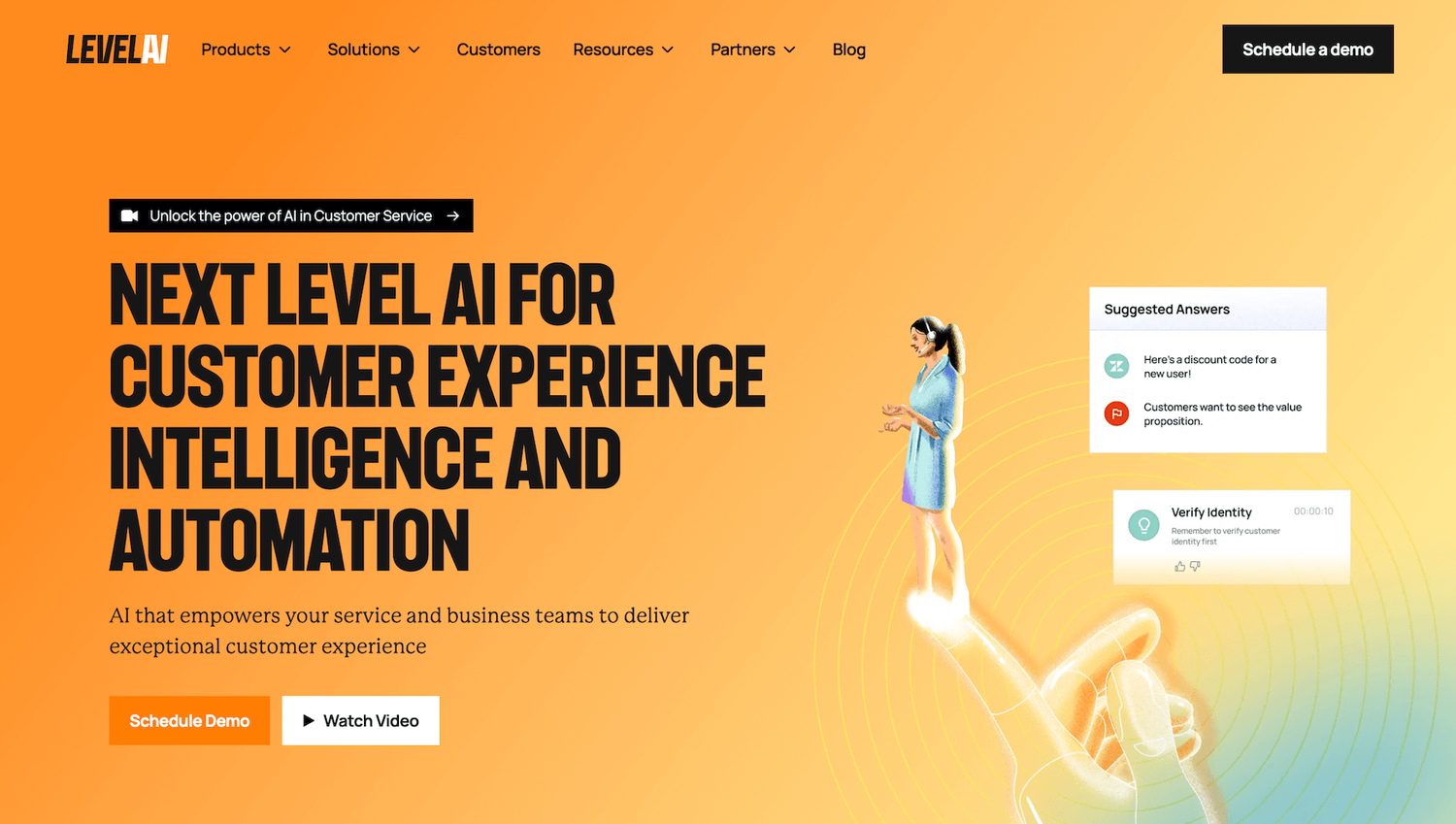
Level AI is a contact center automation platform that actually understands what agents and customers are saying, allowing it to catch real issues, flag coaching moments, and turn every conversation into something useful: not just a transcript, but actionable insights.
As automation software, Level AI doesn’t just reduce manual effort. It eliminates a lot of it. It reviews 100% of customer interactions automatically, which means no more cherry-picking a handful of calls for QA. And now, with the introduction of AI Virtual Agent, you can bring that same intelligence to fully automated conversations. Whether it's live agent interactions or AI-powered chats, Level AI ensures co
It works across all channels, transforming unstructured conversations into searchable, analyzable data. That means you’re not just collecting information. You’re spotting patterns: repeated frustrations, coaching gaps, or even emerging product issues.
Level AI works in both directions. It analyzes past conversations to power post-call quality assurance and coaching. It also provides real-time insights, helping managers monitor live interactions as they happen, allowing them to step in, coach, or course-correct instantly.
In short, the platform helps your team do more with the same headcount. It brings automation to the heart of QA and agent development, turning every interaction into an opportunity for better performance and customer experiences.
From Keywords to Context: Accurate Intent Detection
One of the most compelling things automation can do in a contact center is understand why customers are reaching out. Level AI uses near-human language understanding to detect customer intent and context, even in complex or messy conversations. This shifts contact centers from being reactive and manual to proactive and automated.
At the heart of this is Level AI’s Scenario Engine. It uses natural language understanding (NLU) and semantic intelligence to evaluate conversations automatically. Instead of just scanning for keywords, it understands what’s actually being said, and more importantly, what it means.
That’s a big leap from old-school, rule-based systems (which are also very manual to set up). With those, you have to list all the keywords someone might use to express something like “cancel an order.”
But people don’t always say things the same way. For example, if a customer says, “I was about to cancel my order, but I found matching shoes, so I’m keeping it,” a keyword system might wrongly tag that as a cancellation. It picks up on the word “cancel,” but misses the actual intent.
Level AI avoids these false positives by understanding the full sentence. It can tell the difference between someone casually mentioning “cancel” and someone who actually wants to cancel. That’s the power of AI-driven semantic intelligence: it focuses on meaning, not just matching words.
Instead of relying on massive lists of keywords, Level AI works with scenarios: these are pre- or custom-defined intents that the system looks for in conversations. It even comes with a library of ready-to-use scenarios out of the box, and admins can add their own by simply entering a few example phrases. No need to spell out tens or hundreds of variations.
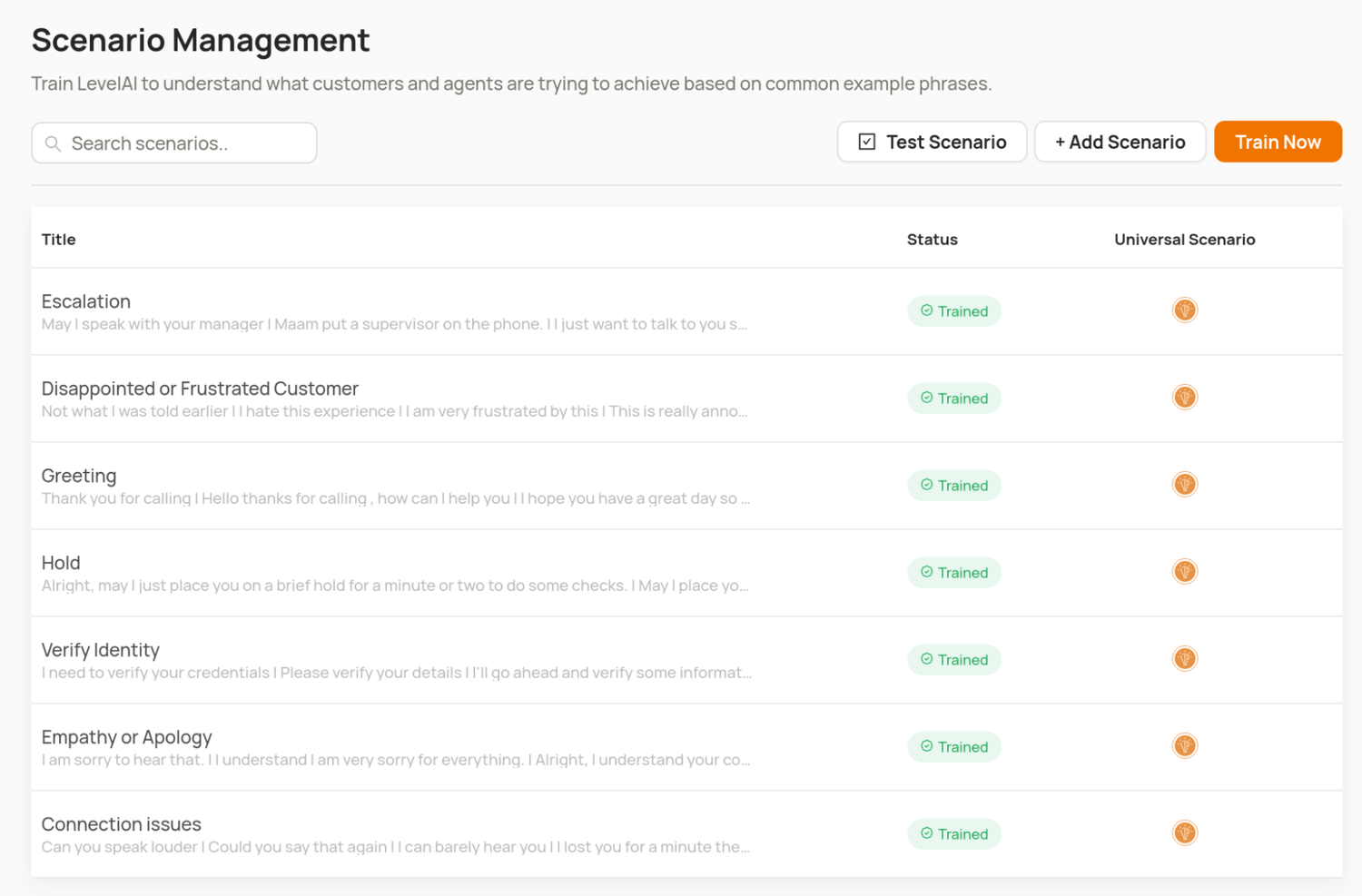
Once scenarios are detected, Level AI automatically tags them right in the conversation. These conversation tags are searchable and filterable, so teams can spot trends and dig into patterns with just a few clicks. Want to find every customer who talked about canceling a service last month? Just search for the “Service cancellation” tag; no keyword searching needed.
This not only improves automation but also makes it more useful. Instead of chasing keywords, you capture real intent and turn that into action.
Emotional Intelligence at Scale
When your contact center can read between the lines (i.e., pick up on emotions like anger, happiness, or disappointment), it stops reacting and starts responding with real emotional intelligence. Level AI helps you do that by automatically detecting emotional cues from every customer interaction.
This emotional awareness isn’t just nice to have; it’s powerful. It lets your team prioritize escalations based on urgency and emotional intensity, and coach reps using insights into how customers feel, not just what they say.
Most tools on the market offer basic sentiment metrics, like that numeric scale from -2 to +2 we talked about earlier. But that doesn’t tell you much about what the customer was actually feeling. Was it frustration? Confusion? Or just impatience?
Level AI goes deeper. It identifies eight distinct emotions during a conversation (the most of any software in its category), giving you a much richer picture of a customer’s emotional journey:
- Anger
- Annoyance
- Disapproval
- Disappointment
- Worry
- Happiness
- Admiration
- Gratitude
The platform identifies occurrences of each of these emotions in a conversation using sentiment tags, which, just as with conversation tags, allow you to search and find all conversations where a particular emotion occurred.
Level AI provides a Sentiment Score at the end of each conversation to capture a customer’s overall feeling during the interaction. It’s important to reflect the range of emotions captured during the call: someone might start with annoyance, and end it feeling entirely different, especially if the call was resolved to their satisfaction.
The score is rated from 0 to 10, with a zero meaning the customer had experienced very negative emotions overall, and a 10 meaning they had a great experience. But this isn’t just a flat average: it’s weighted.
The system puts more emphasis on how the customer felt at the end of the interaction, because that’s the feeling they’re most likely to come away with and associate with your brand.

This gives you a true read on how customers are experiencing your service, at scale, without relying on surveys that many people never fill out.
Read our latest article on top SurveyMonkey alternatives.
Effortless Agent QA with AI-Powered Scoring & Review
Agent quality assurance doesn’t have to be a time-consuming grind. With Level AI’s automation features, you can skip the tedious manual reviews and get instant, structured insights into how your team is doing. It’s a good move for anyone looking to learn how to improve quality assurance in a call center.
Level AI uses auto-scoring and smart tagging (using conversation and sentiment tags) to handle QA at scale. This means every customer interaction is automatically evaluated, categorized, and scored: no more digging through random call samples or trying to keep scoring consistent across reviewers.
At the heart of this is InstaScore, Level AI’s auto-scoring system. It evaluates agent performance against your predefined QA rubrics and then assigns a single, objective percentage score to each conversation. Whether it’s a 92% or a 67%, you can instantly see how well the agent performed: no guesswork required.
And it’s not just for post-call review. InstaScore shows up in Level AI’s QA dashboards and in real time via Real Time Manager Assist (described below), so you can spot coaching opportunities or flag problems while calls are still in progress:
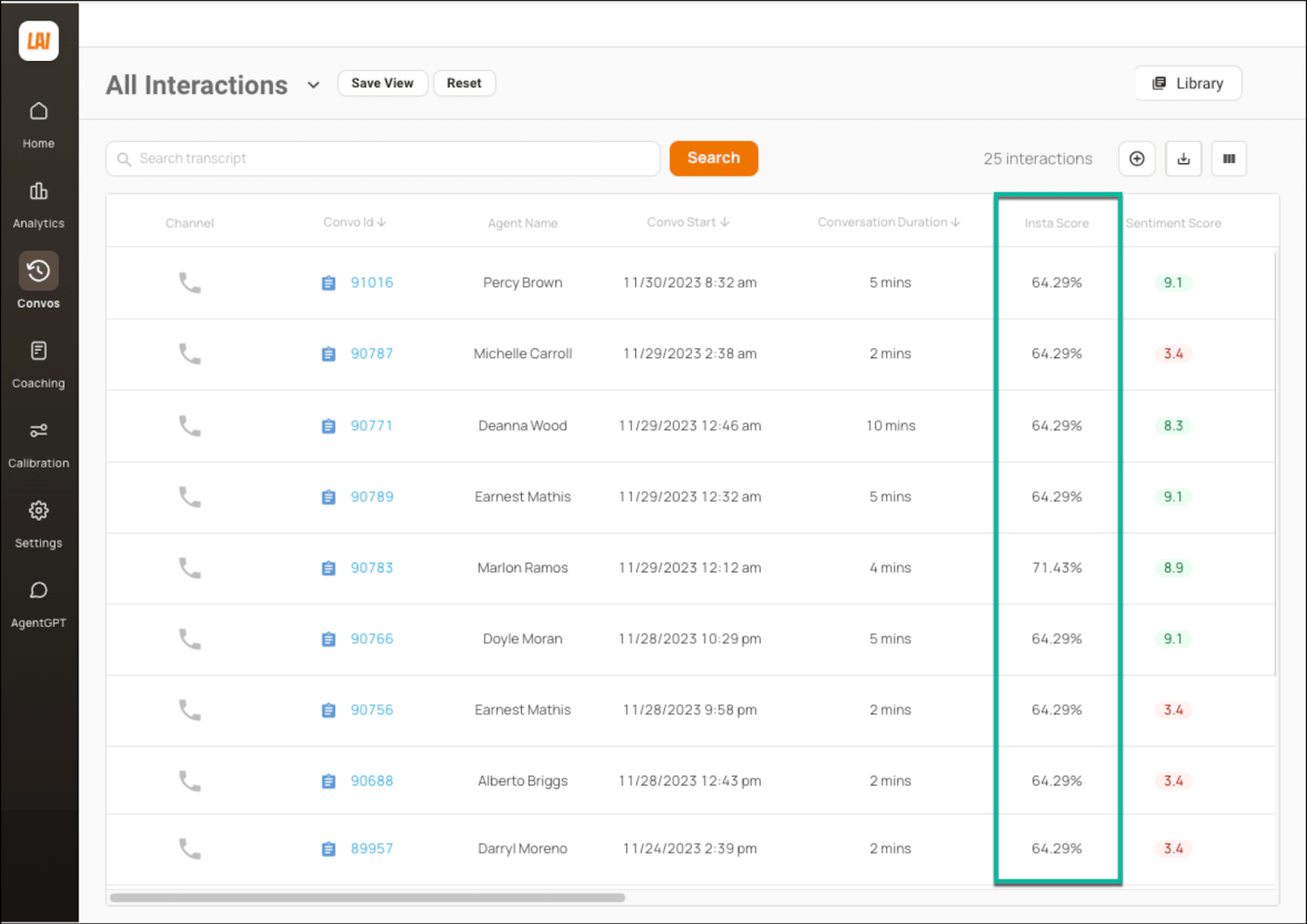
The result? Faster coaching, more consistent evaluations, and smarter decision-making across your team, all without adding extra workload.
One real-world example: after implementing Level AI’s InstaScore and targeted action plans based on agent performance, a multinational design and marketing firm boosted their overall QA scores from 60% to 88%. With automation handling the heavy lifting, they were able to focus on what mattered most: coaching better, faster, and at scale.
Level AI also helps you zero in on the conversations that actually matter with its InstaReview feature.
InstaReview automatically flags conversations that need a closer look, either because something went wrong or because they’re rich in coaching value. Instead of relying on time-consuming tasks like random sampling or hoping to stumble across a useful call, you can go straight to the interactions that actually matter.
What gets flagged? A few examples:
- Conversations with a Sentiment Score below 6 signal a negative customer experience.
- Calls with a high number of assists, suggesting the agent needed a lot of support.
- Interactions with unusually long wait times could point to confusion or escalation.
In the dashboard, flagged conversations are marked with bold, multi-colored tags that make it easy to spot patterns at a glance. You can instantly identify the types of calls that are worth reviewing, without wasting time listening to calls that lead nowhere:

By highlighting these moments, InstaReview lets you focus your time on the conversations that can drive real improvements; it’s also a good way to implement call center quality assurance best practices without adding extra workload. Whether it’s coaching a struggling rep, analyzing why a call went sideways, or celebrating a win, you’ll be acting on data, not guesswork.
Live AI Guidance for Proactive, High-Impact Support
One of the most immediate and impactful forms of contact center automation is real-time support for agents and managers. This gives instant, AI-powered insights while the conversation is happening, not just after the fact.
For agents, this means never flying blind. The system listens in on the call (so to speak), figures out what the customer is asking, and serves up helpful info right on the spot. That could be a step-by-step guide, an FAQ, a warning, or even a script; whatever helps the agent solve the problem faster. And as the conversation evolves, the suggestions update automatically.
Level AI’s Real-Time Agent Assist detects customer intent behind the scenes and pulls in relevant knowledge cards from across your company’s databases:
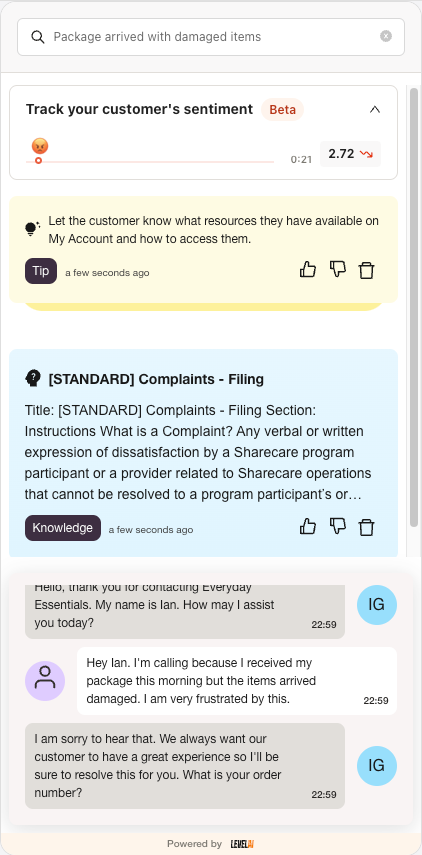
The system’s search function, AgentGPT, even predicts what the agent will need next and auto-fills the search tab with relevant suggestions.
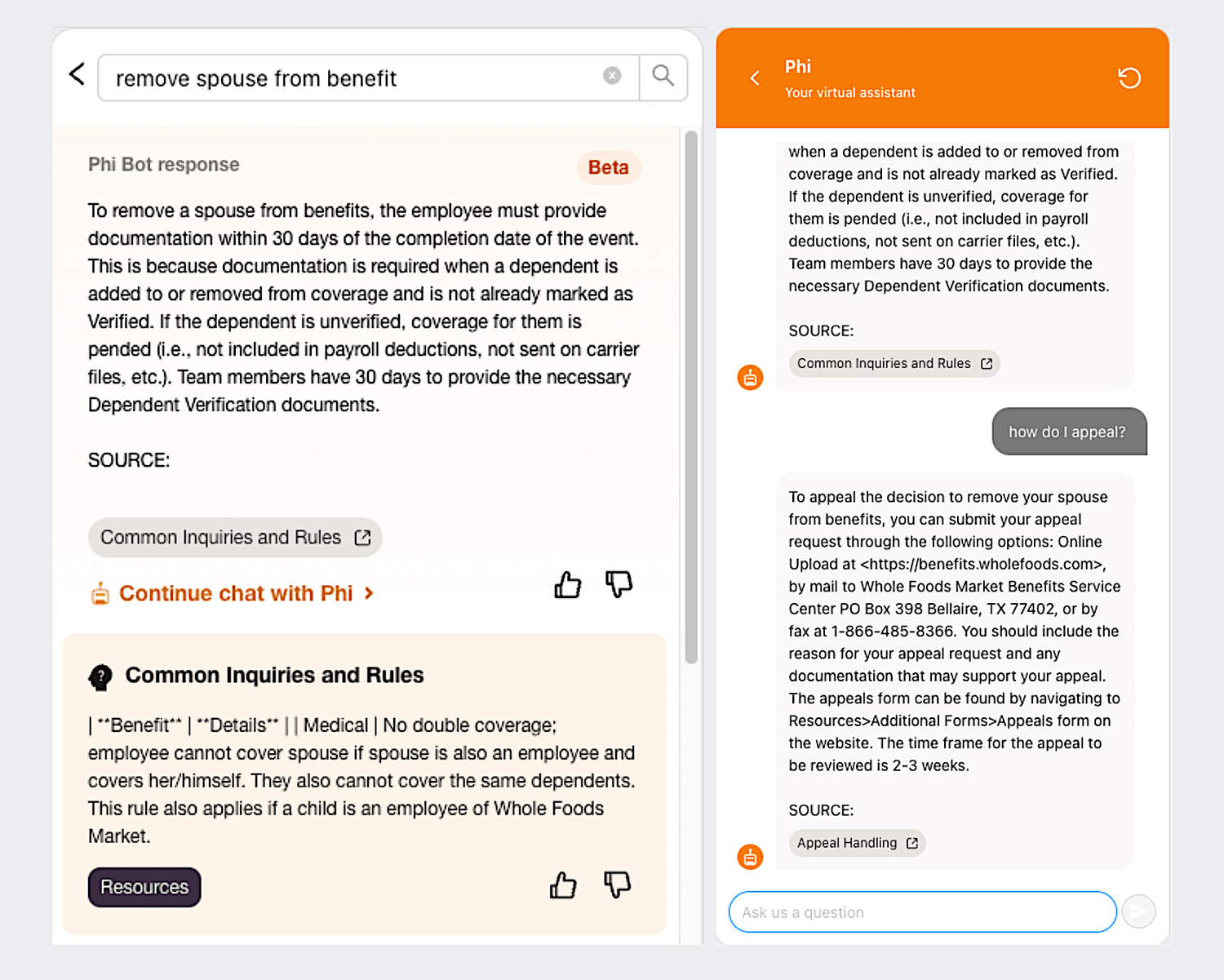
Agents can rate these suggestions with a thumbs up or down, helping the system learn and improve over time. Because agents get accurate answers faster, they spend less time scrambling and more time resolving.
One insurance provider used Level AI’s real-time guidance to empower their agents on live calls, cutting average handle times by 20% and boosting first call resolution rates by 15%. With the right information at their fingertips, agents were able to work faster, solve issues more efficiently, and deliver a better customer experience.
For supervisors, Real-Time Manager Assist delivers live dashboards with key call metrics. You see call duration, conversation Sentiment Score, conversion probability, estimated deal size, and even the agent’s InstaScore, all in real time. No more bouncing between tools or pulling reports hours later.
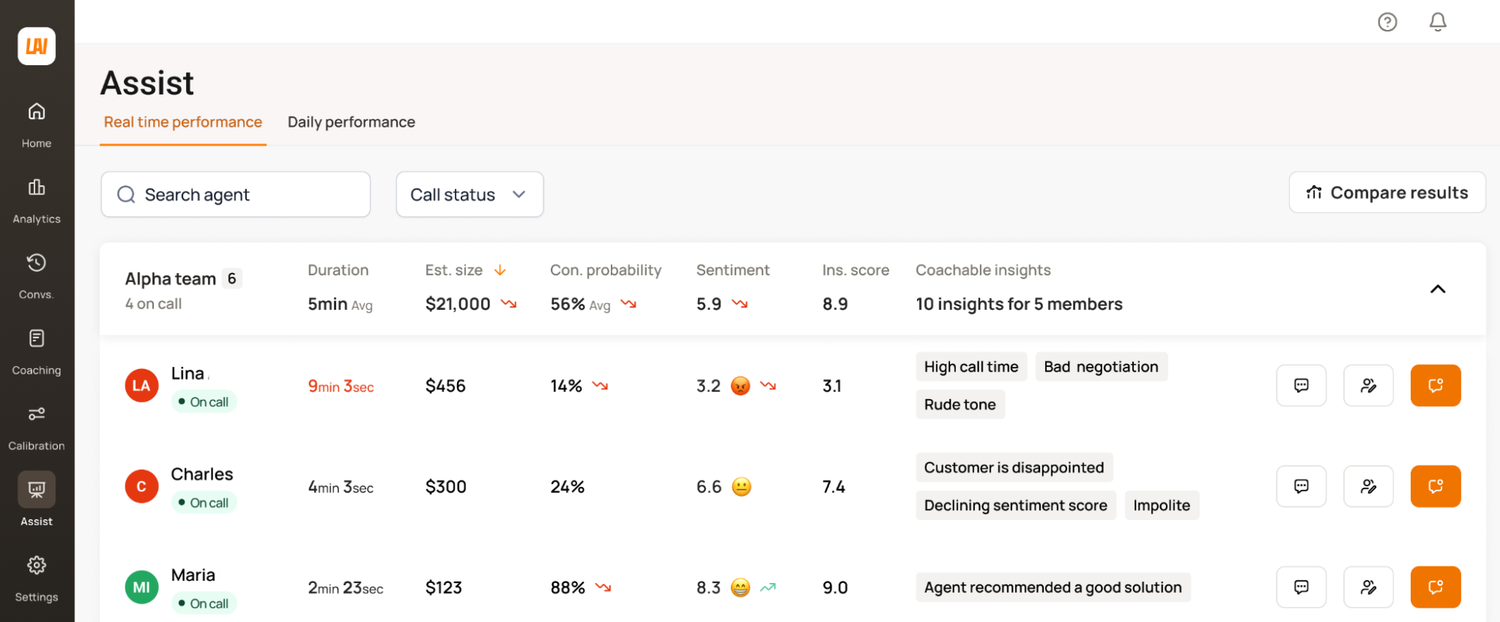
If a call starts to go south, you’ll know instantly. You can whisper advice to the agent, use call barging, or just keep tabs on high-risk interactions without lifting a finger. And if you don’t have time to monitor every call? Set up custom alerts that ping you on Slack or Microsoft Teams when something important, like a possible churn risk, comes up.
See our latest article on how to monitor call center performance.
Automating VoC Insights at Scale
Most contact centers have relied on post-call surveys to gather voice of customer (VoC) insights. But surveys don’t tell the whole story. They only capture a subset of real customer responses, and only that feedback that you know to ask for.
Level AI flips that script with call center voice analytics that analyze all natural customer interactions to gather VoC Insights at scale. That means you're getting a complete picture of what customers are saying, how they’re feeling, and what’s frustrating them, even those who may not feel strongly one way or the other about your brand, product, or service (the majority of whom tend not to respond to surveys).
Our platform pulls traditional VoC metrics like CSAT, NPS, and CES directly from conversations without follow-up surveys. This saves your team time, gets you more consistent data, and captures how all your customers feel, not just the loudest voices.
It also surfaces more subtle trends and recurring pain points you may not have initially noticed: repeated complaints about product durability, confusion over return policies, or requests for missing features.
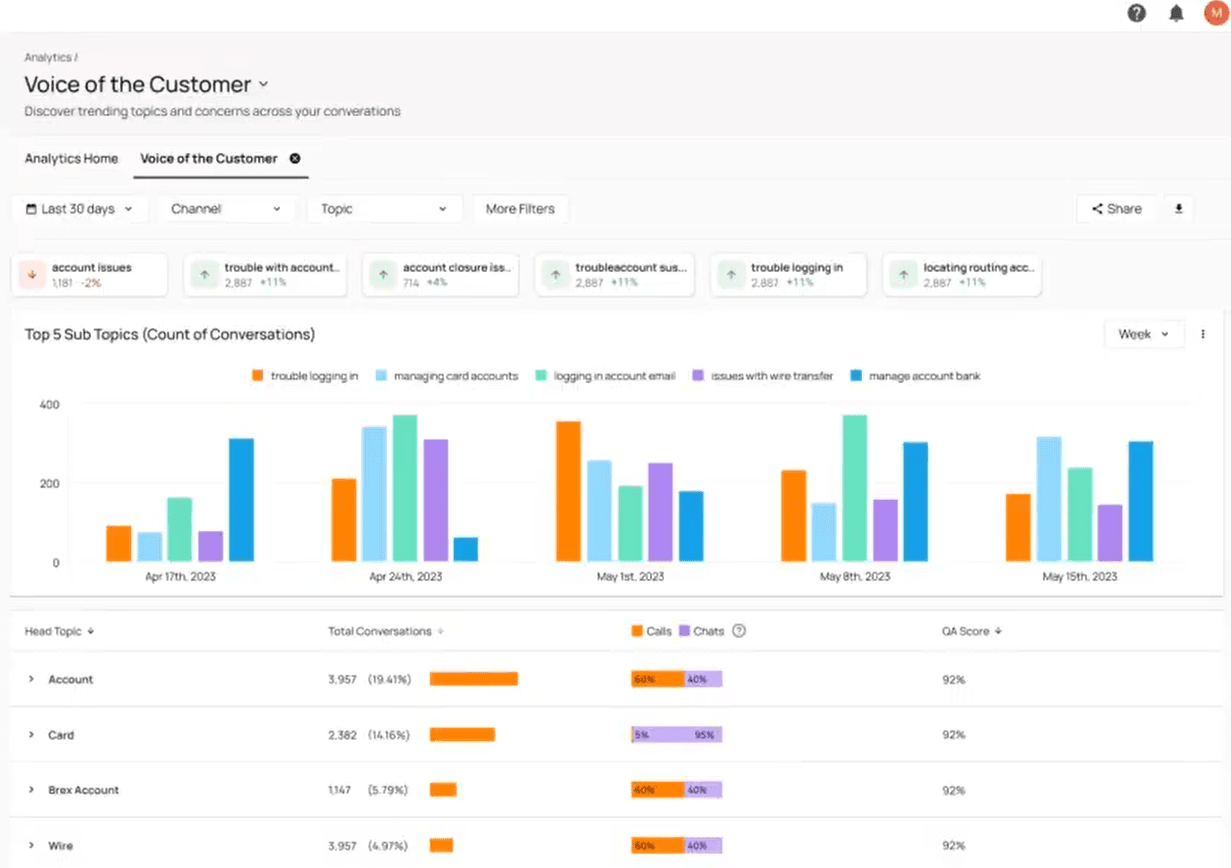
And then there’s iCSAT, Level AI’s next-gen customer satisfaction metric. It gives you a complete view of customer experience on a scale from 1 to 5, based on three key elements:
- Resolution Score: Did the customer’s issue actually get resolved?
- Sentiment Score: How did the customer feel throughout the interaction?
- Customer Effort Score: How much work did the customer have to do, like repeating account details or getting transferred multiple times?
This combo gives you a clearer, more accurate read on customer satisfaction than any one-dimensional score can.
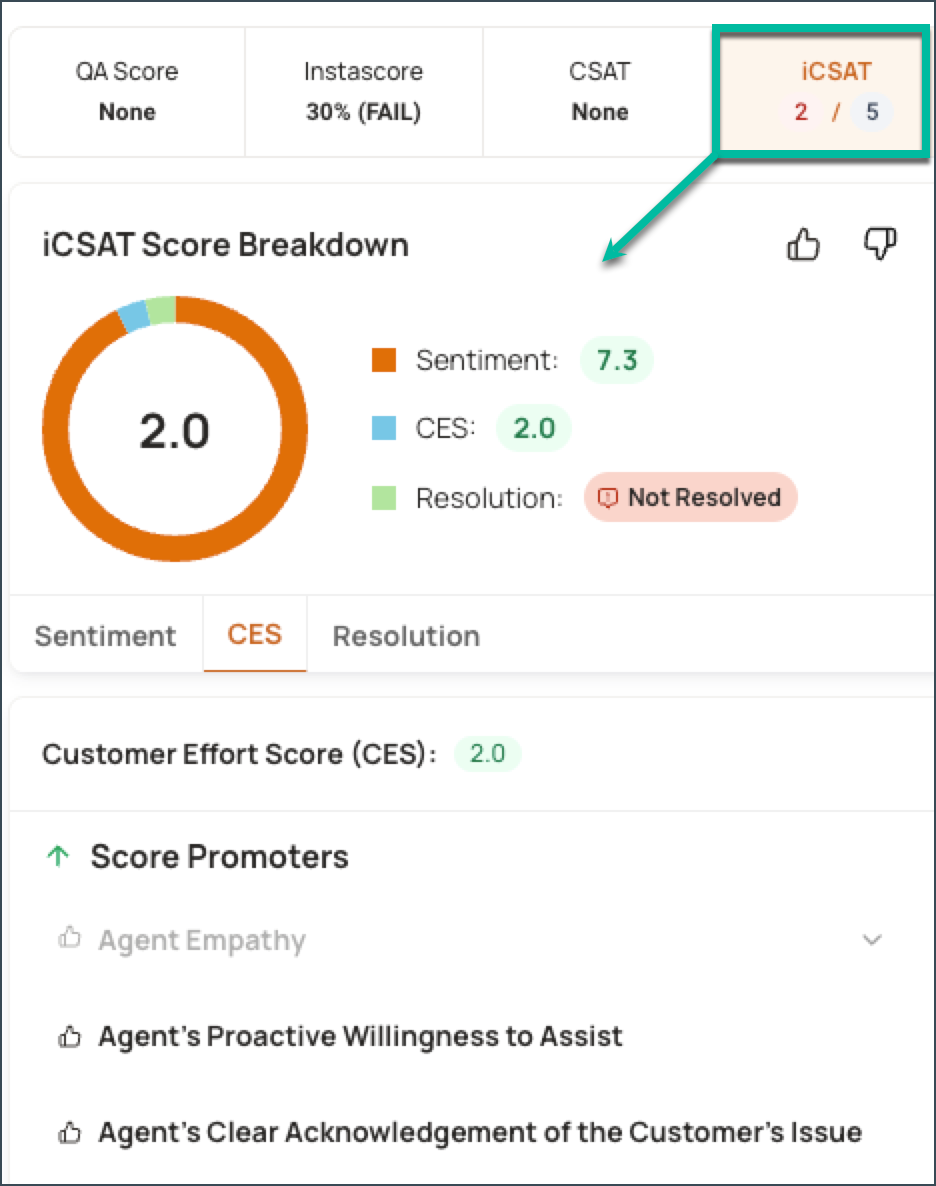
Managers and QA teams use iCSAT within the call center analytics dashboard to spot unmet needs and figure out what’s dragging satisfaction down, without digging through hours of call recordings. For example, if iCSAT reveals that customers regularly get frustrated after being transferred more than once, that’s a signal to tighten up routing or give agents more authority to handle issues directly.
Schedule a free demo today to see how AI-powered automation can change your contact center and help you spot risks, resolve issues faster, and coach more efficiently.
2. Zendesk: Automates Customer Service Workflows
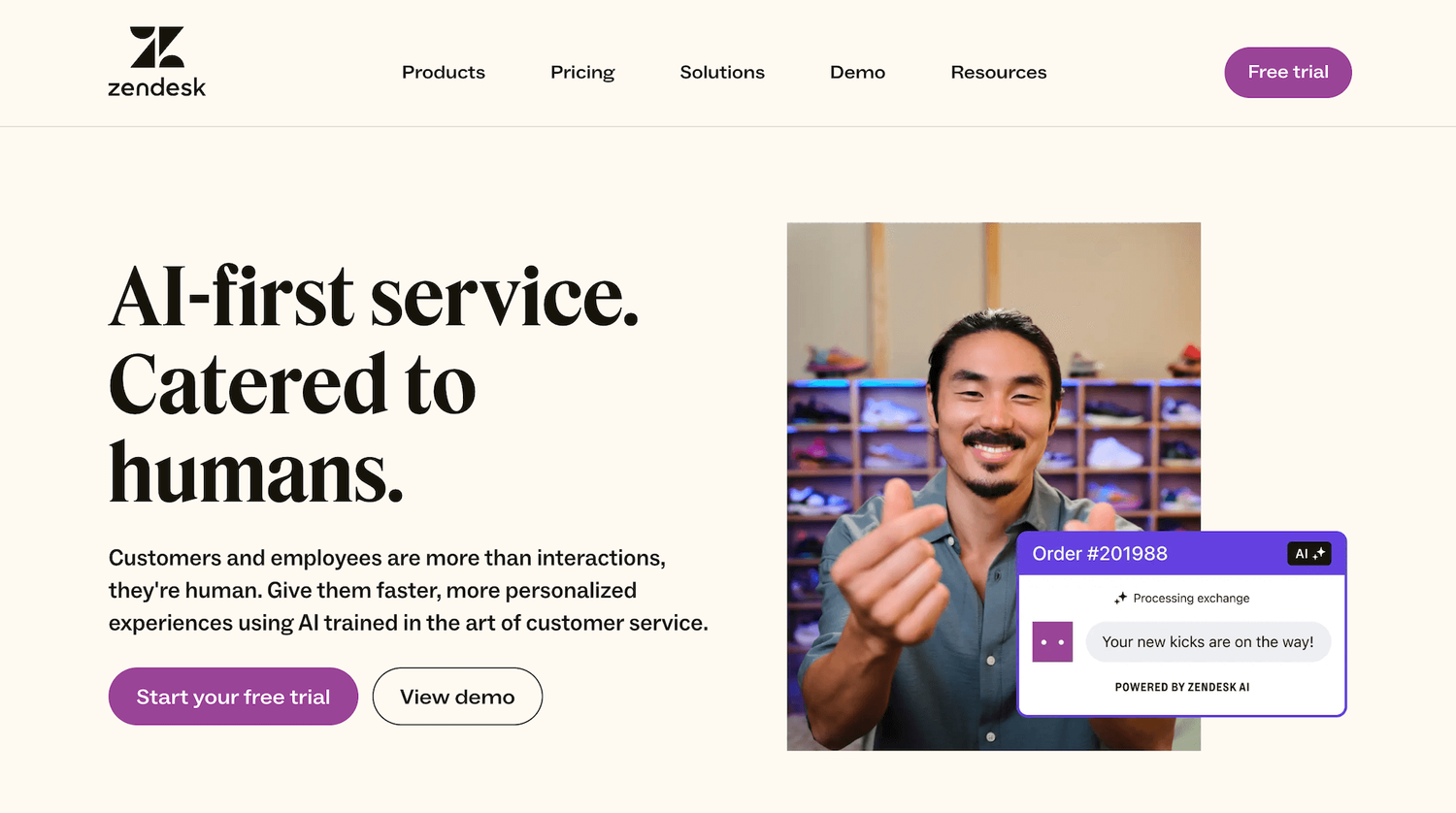
Zendesk is a cloud-based platform that provides tools for customer support use cases like managing support tickets, automating workflows, and delivering self-service options. Zendesk includes features for ticket management, multi-channel communication, knowledge base creation, and reporting.
Key features:
- Uses workflow automation to categorize and route tickets based on intent, sentiment, language, agent skill, capacity, and ticket priority.
- Supports AI-powered chatbots and virtual agents to handle routine inquiries, provide instant responses, and gather customer information before escalating to a human agent.
- Provides APIs and SDKs for integration and customization, allowing organizations to extend functionality and connect with other systems.
- Automated reporting features track key metrics such as response times, resolution rates, and customer satisfaction scores, allowing for continuous optimization of support operations.
Zendesk’s pricing starts at around $55 per agent per month for their Suite Team (multichannel support and workflow automation).
3. Five9: Manages Customer Interactions Across Channels

Five9 is contact center automation software that helps organizations manage and optimize customer interactions across multiple channels and deliver personalized, efficient customer service by leveraging artificial intelligence and collaborative intelligence.
Key features:
- Provides a low-code/no-code solution allowing administrators to visually design and deploy automated processes, such as routing customer inquiries and triggering follow-up actions.
- Offers over 50 pre-built integrations, accelerating setup and reducing the need for custom IT development.
- Uses intelligent virtual agents (IVAs) to handle routine tasks such as payment processing, appointment scheduling, and basic troubleshooting, freeing human agents to focus on complex issues.
- Automates outbound calls using advanced dialing modes that maximize agent talk time and minimize idle periods.
According to their website, Five9 offers separate pricing depending on the bundle of services and features customers get. Pricing starts at around $119 per seat per month for digital interactions only.
4. Genesys Cloud CX: Monitors and Analyzes Interaction Data
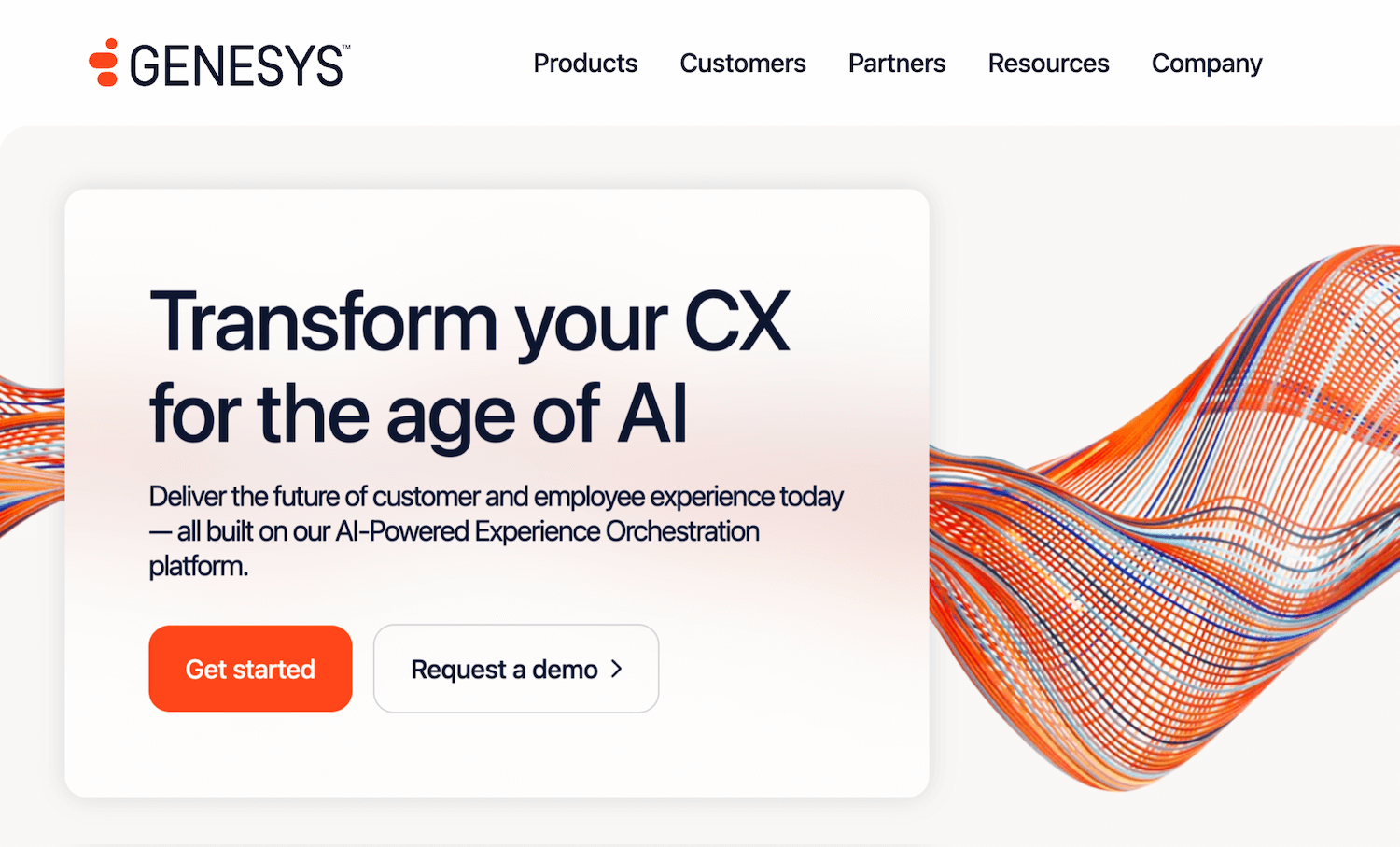
Genesys Cloud CX provides a unified system where staff can view, track, and respond to messages or calls, ensuring that all conversations are organized and accessible in one place. It includes tools for monitoring performance, managing teams, and analyzing interaction data, helping businesses deliver consistent service and improve customer and staff experiences.
Key features:
- Automates call routing and self-service options through customizable phone menus, enabling customers to resolve issues or reach the right department without agent intervention.
- Offers chatbots and voice bots to automate routine customer interactions, such as answering FAQs, processing transactions, and capturing customer intent through natural language understanding.
- Defines and automates multi-step business processes based on pre-set triggers and conditions, such as case creation, follow-ups, and escalations. This reduces manual intervention and ensures consistent handling of tasks.
- Sends automated notifications to customers and agents regarding updates, appointments, or status changes, improving engagement and reducing no-shows.
Genesys Cloud CX offers several subscription plans, each billed annually per user, with pricing and features designed to fit different contact center needs. These start at a minimum of $2,000 (paid annually), according to their website.
5. Nice CXOne: Intelligent IVR and Call Handling
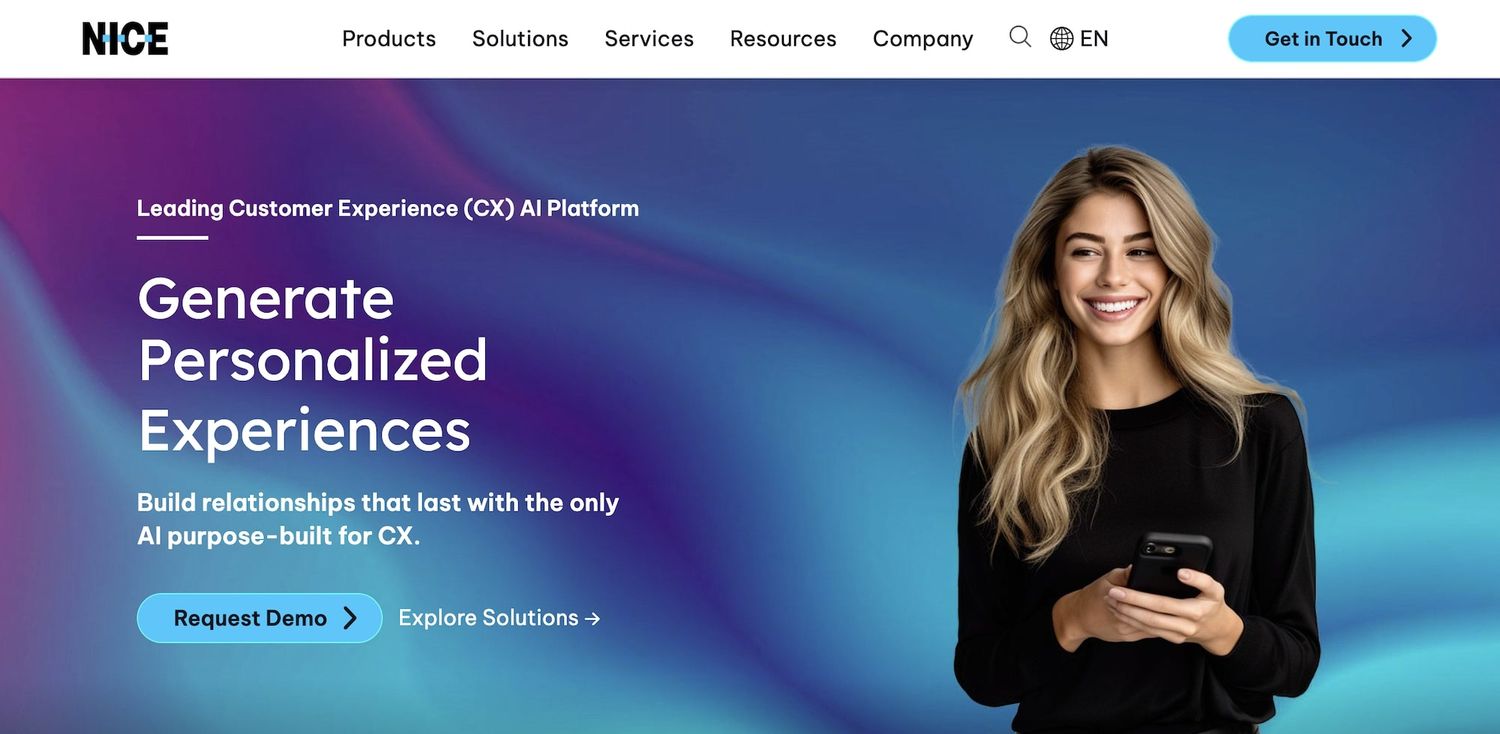
Nice CXOne is a cloud-based CX platform that offers conversational bots, speech analytics, and predictive routing, facilitating personalized customer interactions and increasing resolution rates.
Key features:
- Omnichannel routing of customer inquiries to the most suitable agent or self-service resource using AI algorithms.
- Deploys intelligent virtual agents and chatbots for voice and digital channels to handle routine inquiries, provide self-service options, and escalate complex issues to human agents.
- Natural language and touch-tone IVR systems that automate call handling, information retrieval, and customer authentication.
- Automated scheduling, forecasting, and shift bidding to optimize staffing levels. The Employee Engagement Manager module automates shift approvals and gamifies performance to boost agent engagement.
NICE CXone uses a tiered, per-user, per-month pricing model, with plans designed to fit different contact center needs and levels of automation. According to the website, pricing starts at around $70 per user per month, depending on the modules you want to use.
6. Talkdesk: Reduce Manual Effort with Automated Ticket and CRM Updates
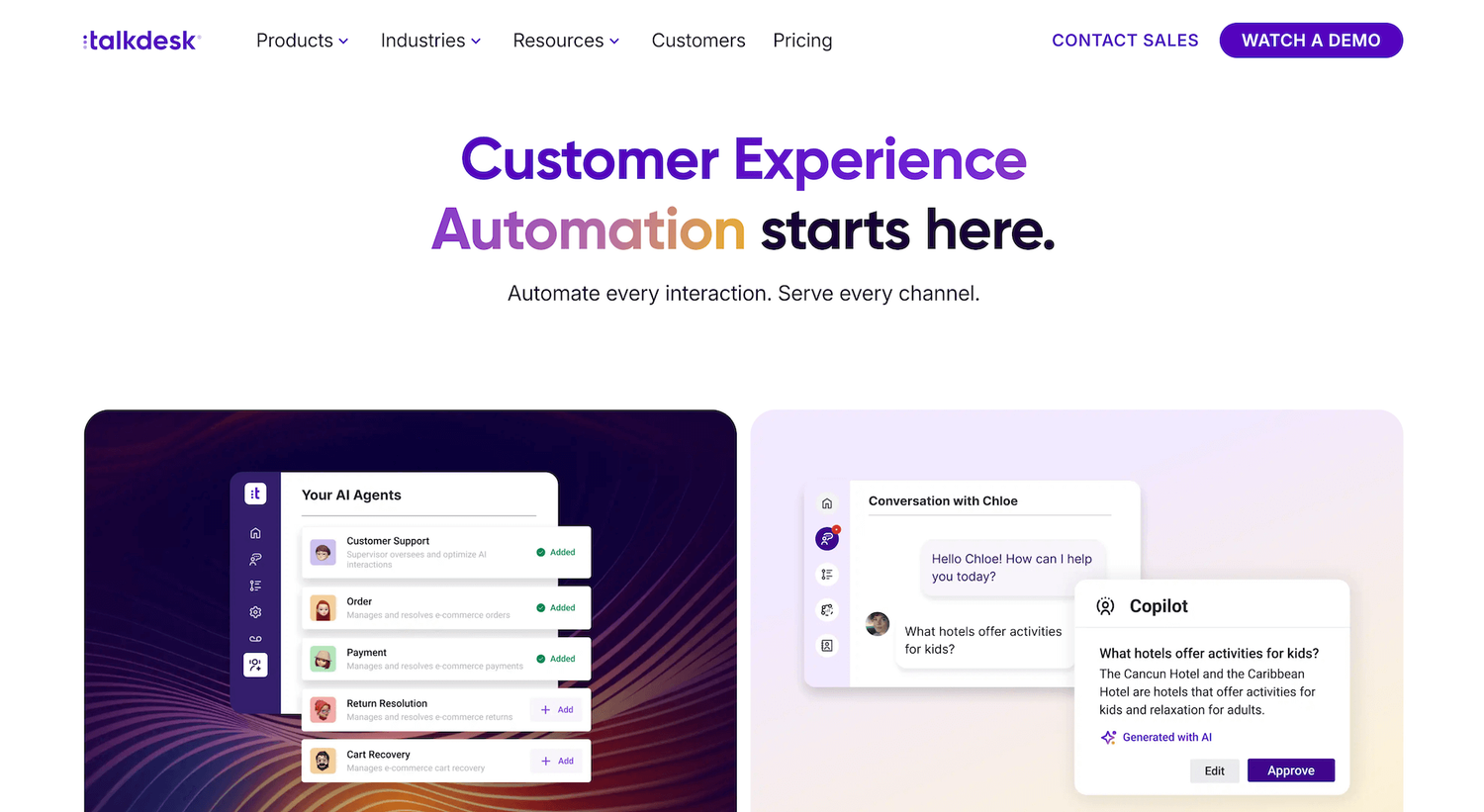
Talkdesk is a platform that helps organizations manage and automate customer interactions across multiple channels using advanced routing, artificial intelligence, and seamless integrations to streamline workflows, improve agent productivity, and enhance the customer experience.
Key features:
- Provides configurable multi-level IVR menus to automate call handling, enabling callers to resolve issues or reach the appropriate department without agent intervention.
- Offers an automatic call distributor (ACD) that routes inbound calls based on caller data, IVR selections, business hours, and agent skills to ensure customers are connected to the right resource efficiently.
- Utilizes generative AI and machine learning to automate repetitive tasks, suggest agent responses, and allow self-service options through virtual agents and chatbots.
- Automates post-call processes such as CRM data entry, ticket creation, and follow-up actions, reducing manual effort and improving accuracy.
Talkdesk pricing starts at $85 per user per month for the CX Cloud Digital Essentials plan.
7. 8x8 Contact Center: Unifies Agent Workspaces for Efficient Support
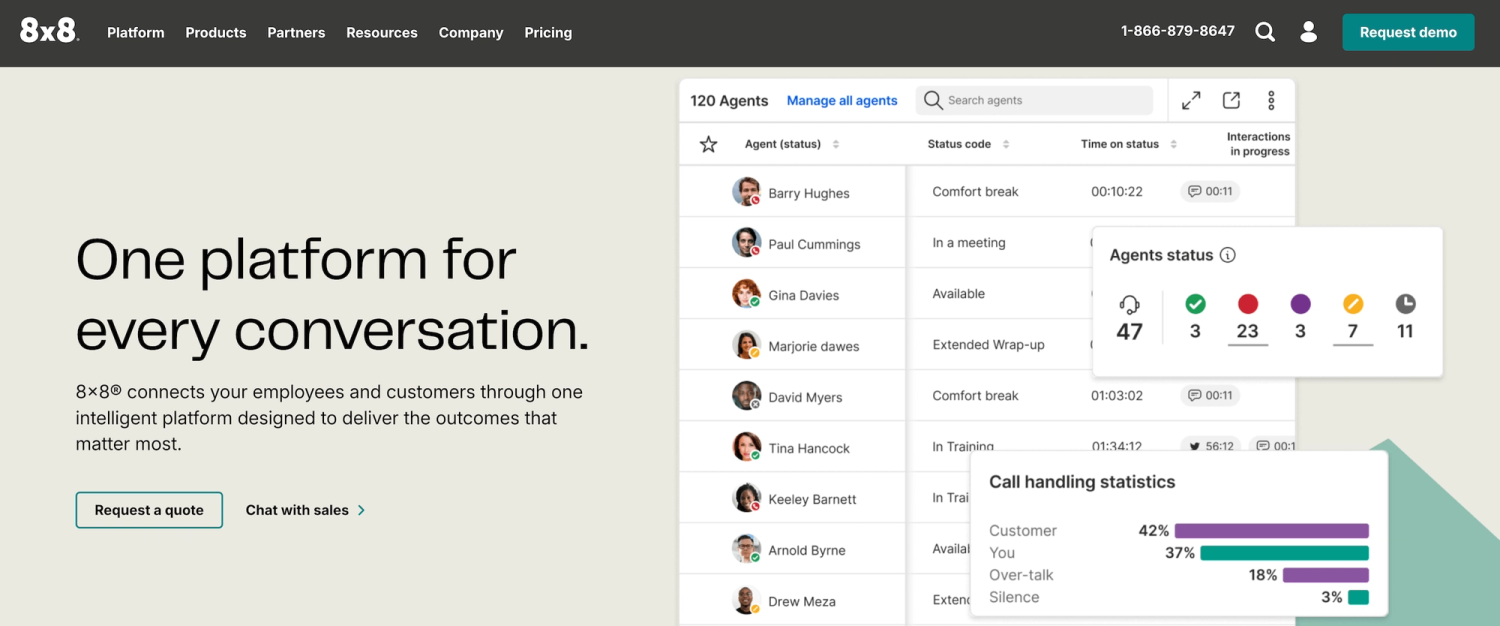
8x8 Contact Center is a cloud solution that improves customer engagement and empowers agents and supervisors with intuitive, web-based workspaces to simplify operations.
Key features:
- A unified agent workspace with tools, customer history, and real-time assistance to provide efficient support.
- Real-time and historical insights into key performance metrics to help monitor compliance, evaluate agent performance, and identify training opportunities.
- Tools for scheduling, feedback, and collaborative coaching help optimize agent productivity and satisfaction.
- An auto dialer supporting preview, progressive, and predictive dialing modes, automating outbound campaigns, and maximizing agent efficiency.
According to the website, you must request a quote.
Start Driving Efficiency with Level AI
Level AI’s secure and customizable Generative AI capabilities simplify complex contact center operations by analyzing conversations with near-human understanding and automating routine tasks for faster, smarter service.
Want to experience smarter contact center automation? Get a free demo and see what Level AI can do for you.
Keep reading
View all

